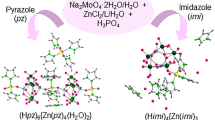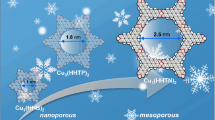Abstract
Three new supramolecular assemblies (constructed through strong hydrogen bonding) of \([\text {Co}_{\mathrm {2}}\text {(bpta)}_{\mathrm {2}}\text {(adc)}(\mathrm {H}_{\mathrm {2}}\mathrm {O})_{\mathrm {4}}](\text {ClO}_{\mathrm {4}})_{\mathrm {2}}^{\mathbf {.}}\mathrm {2H}_{\mathrm {2}}\mathrm {O}\) (1), [ Cu2(bpta)2(fum)(H2O)2](ClO4)2 (2) and [Cu2(bpta)2(tdc)(H2O) (ClO4)](ClO4).3H2O (3), which are synthesised by one pot self-assembly of the metal salt, bpta ligand and the corresponding dicarboxylate under the same reaction conditions, are reported (where adc = acetylene dicarboxylate, fum = fumarate, tdc = 2,5-thiophenedicarboxylate and bpta =N,N′-bis(2-pyridylmethyl)-tert-butylamine). These compounds have varying degrees of coordinated water molecules per dimetal subunits (four for 1, two for 2 and one for 3, respectively). Furthermore, the orientation of the coordinated water molecules in 1 and 2, with respect to the mono (carboxylato)-bridged dimetal subunit, is different (cis and trans, respectively). On the other hand, there is a coordinated perchlorate ion in 3 making the two metal centers inequivalent. Unlike 1 and 3, there are no lattice water molecules in 2. This difference in the dimetal subunit in 1–3 and the presence or absence of the lattice water molecules are the keys to forming the diverse supramolecular assemblies. In 1 and 3, the involvement of lattice water molecules in the construction of such assemblies is distinctly different. In case of 2, the formation of supramolecular assembly depends on the coordinated water molecule (trans to each other) and thus a ladder shaped supramolecular assembly is the result. The strength of hydrogen bonding observed in the networks of 1–3 is indicated in the O· · ·O distances (2.596 Å to 3.160 Å) and the O-H...O angles 124∘ to 176∘. All are characterised by elemental analysis, FTIR spectroscopy and single crystal X-ray diffraction studies.

Diverse supramolecular assemblies with varying degree of coordinated water molecules per dimetal subunits of Co(II) or Cu(II) (four for 1, two for 2 and one for 3, respectively)comprised of a flexible tridentate ligand and dicarboxylate linkers are reported.










Similar content being viewed by others
References
(a) Lehn J-M 1995 InSupramolecular Chemistry: Concepts and Perspectives (New York: VCH); (b) Steed J W, Atwood J L 2009 In Supramolecular Chemistry (UK: John Wiley)
Dmitriev A, Lin N, Barth J V and Kern K 2003 Angew. Chem. Int. Ed. 42 2670
(a) Kitagawa S, Kitaura R and Noro S 2004 Angew. Chem. Int. Ed. 43 2334; (b) Tranchemontagne D J, Mendoza-Cortés J L, O’Keeffe M, Yaghi O M 2009 Chem. Soc. Rev. 38 1257; (c) Kurmoo M 2009 Chem. Soc. Rev. 38 1353; (c) O’Keeffe M, Yaghi O M 2012 Chem. Rev. 112 675; (d) Suh M K, Park H J, Prasad T K and Lim D-W 2012 Chem. Rev. 112 782; (e) Li J-R, Sculley J and Zhou H-C 2012 Chem. Rev. 112 869; (f) Kreno L F, Leong K, Farha O K, Allendorf M, Van Duyne R P and Hupp J T 2012 Chem. Rev. 112 1105; (g) Cui Y, Yue Y, Qian G and Chen G 2012 Chem. Rev. 112 1126
(a) Desiraju G R 2003 In Crystal Design: Structure and Functions (Perspectives in Supramolecular Chemistry) (England: John Wiley); (b) Desiraju G R, Vittal J J and Ramanan A 2011 In Crystal Engineering. A Text Book (Singapore: World Scientific)
Burrows A D, Chan C W, Chowdhry M M, McGrady J E and Mingos D M P 1995 Chem. Soc. Rev. 24 329
Brammer L 2003 In Perspective in Supramolecular Chemistry - Crystal Design: Structure and Function G. R. Desiraju (Ed.) (England: Wiley) Vol. 7, pp 1–75
Beatty A M 2001 CrystEngComm 3 243
Aakeroy C B and Beatty A M 2001 Aust. J. Chem. 54 409
Desiraju G R 2000 J. Chem. Soc., Dalton Trans. 3745
Subramanian S and Zaworotko M J 1994 Coord. Chem. Rev. 137 357
Mok H J, Davis J A, Pal S, Mandal S K and Armstrong W H 1997 Inorg. Chim. Acta 263 385
APEX2, SADABS and SAINT 2008 Bruker AXS inc: Madison, WI, USA
Sheldrick G M 2008 Acta Crystallogr., Sect. A: Found. Crystallogr. 64 112
Macrae C F, Bruno I J, Chisholm J A, Edginton P R, McCabe P, Pidocck E, Rodriguez-Monge L, Taylor T, Van de Streek J and Wood P A 2008 J. Appl. Crystallogr. 41 266
Spek A L 1999 PLATON, Version 1.62, University of Utrecht
(a) Khullar S and Mandal S K 2012 Cryst. Growth Des. 12 5329 and references therein; (b) Khullar S and Mandal S K 2013 Cryst. Growth Des. 13 3116; (c) Khullar S, Gupta V and Mandal S K 2014 Cryst Eng Comm 16 5705
(a) Skoulika S, Dallas P, Siskos M G, Deligiannakis Y and Michaelides A 2003 Chem. Mater. 15 4576; (b) Stein I and Ruschewitz U 2009 Z. Naturforsch., B: J. Chem. Sci. 64 1093; (c) Wang H-Y, Gao S, Huo L-H and Zhao J-G 2007 Acta Crystallogr., Sect. E: Struct. Rep. Online 63 m2995
Wang Y Y, Wang X, Shi Q Z and Gao Y C 2002 Trans. Metal Chem. 27 481
(a) Chen B L Mok K F, Ng S C, Feng Y L and Liu S X 1998 Polyhedron 17 4237; (b) Chen B L, Mok K F, Ng S C and Drew M G B 1999 Polyhedron 18 1211
Xiao H P 2005 Acta Crystallogr. E61 m2592
Yeşilel O Z, İlker I, Büyükgüngor O 2009 Polyhedron 28 3010
Acknowledgements
Funding for this work was provided by IISER, Mohali. S. K. is grateful to CSIR, India for research fellowship. The use of X-ray and NMR facilities at IISER, Mohali, and CIL, NIPER, Mohali for CHN analysis are gratefully acknowledged. We thank one of the referees for helpful suggestions.
Author information
Authors and Affiliations
Corresponding author
Additional information
Supplementary Information
Crystallographic data of the structures 1–3 in CIF format (CCDC 1000552-1000554, respectively). Copies of the data can be obtained, free of charge, on application to CCDC, 12 Union Road, Cambridge CB2 1EZ, UK, (fax: + 44-(0)1223-336033 or e-mail: deposit@ccdc.cam.ac.uk)
Rights and permissions
About this article
Cite this article
KHULLAR, S., MANDAL, S.K. Construction of diverse supramolecular assemblies of dimetal subunits differing in coordinated water molecules via strong hydrogen bonding interactions: Synthesis, crystal structures and spectroscopic properties. J Chem Sci 126, 1515–1523 (2014). https://doi.org/10.1007/s12039-014-0685-x
Received:
Revised:
Accepted:
Published:
Issue Date:
DOI: https://doi.org/10.1007/s12039-014-0685-x




